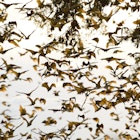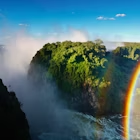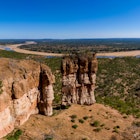

© Image by Wolfgang_Steiner/Getty Images
When Victoria Falls closed to tourists almost two months ago, it seemed like a precautionary move. The city of Livingstone, just outside Mosi-oa-Tunya National Park, hasn't yet seen a case of the novel coronavirus. Tour guides were eager to get back to work, the falls were at their seasonal peak and on May 12, Zambian President Edgar Lungu reopened the iconic Unesco world heritage site.
Already, over a thousand people have returned to see the falls – a boon for the local economy. It's already been a tough year for the area's tourism industry. Just a few months ago, reports circulated around the world suggested the annual dry season, when significantly less water flows over the falls, was actually the product of climate change.
The idea that Victoria Falls might permanently slow to a trickle spooked potential visitors and local guide companies alike. Visitors feared that Victoria Falls might no longer exist as we know it in a few years. The tourism industry feared visitors would stay away, harming the fragile regional economy. In April, however, Victoria Falls not only saw its high water season return right on schedule, it recorded the heaviest flow in a decade.

“What a sad and disappointing irony it is, that one of the Seven Natural Wonders of the World is at its finest at this time, but the world is in lockdown and very few, if any, will get to witness or experience this iconic destination in all its splendor," explained Ross Kennedy of Africa Albida Tourism to Finlay Greig of the UK news outlet – inews – in late April.
It could take some time for tourism rates to bounce back as impressively as the falls' flow, however. According to the Associated Press, South African Airways just suspended all international flights until June, and Ethiopian Airlines – the continent's largest carrier – has also significantly scaled back service.
Meanwhile, as the rate of COVID-19 increases across Africa, many countries are extending travel restrictions and stay at home orders, prompting concerns for visitors and expats about their ability to get home should circumstances change. Victoria Falls, Zimbabwe and Livingstone, Zambia are less than 18 kilometers (11 miles) apart, separated primarily by the falls themselves and the Zambezi River that feeds them.

In March, Zimbabwe announced the country's first COVID-19 case. According to the Associated Press, the patient is a resident of Victoria Falls who returned from the UK via South Africa. Not only after, Zimbabwe declared a national disaster on March 27. To date, according to the US Embassy in Zimbabwe, there have been 46 confirmed cases and four deaths. On May 16, Zimbabwean President Emmerson Mnangagwa extended the country's nationwide lockdown for at least another two weeks.
Meanwhile, Zambia has seen 832 cases of COVID-19, and seven deaths, according to data from Johns Hopkins. The country has also been more selective about its restrictions, even reopening its border with Tanzania on May 15 – though only for trucking shipments, not personal travel. The Government of Zambia continues its suspension of all tourist visas.
You may also like:
When can I travel again? How different countries are preparing for the return of tourism
World Tourism Organization report reveals the extent of travel restrictions around the world
Join these wildlife safari drives via live streaming
Explore related stories






 Wildlife & Nature10 natural wonders so pretty you won't believe they're real
Wildlife & Nature10 natural wonders so pretty you won't believe they're realApr 8, 2020 • 4 min read
 Wildlife & NatureAfrica's largest wildlife migration: the bats of Kasanka National Park
Wildlife & NatureAfrica's largest wildlife migration: the bats of Kasanka National ParkOct 2, 2019 • 4 min read

 HotelsThe 'Place of Elephants': why Gonarezhou National Park is Zimbabwe's rising star
HotelsThe 'Place of Elephants': why Gonarezhou National Park is Zimbabwe's rising starSep 6, 2019 • 5 min read
